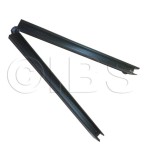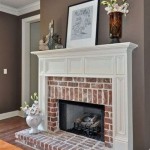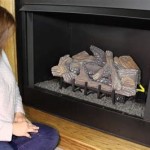```html
Should I Paint My Red Brick Fireplace White?
The decision to paint a red brick fireplace white is a significant one, impacting the aesthetic of a room and potentially affecting the resale value of a property. This article provides a comprehensive overview of the factors to consider before undertaking such a project, outlining the advantages, disadvantages, and essential preparation steps.
The inherent appeal of a red brick fireplace lies in its rustic charm and connection to traditional architectural styles. The warm tones of the brick often contribute a sense of coziness and history to a living space. Conversely, a white painted fireplace offers a more modern, clean, and often brighter aesthetic. The choice between these two styles depends largely on individual preferences and the desired ambiance of the room.
Consideration must be given to the existing décor and architectural style of the home. A whitewashed brick fireplace can seamlessly integrate into a modern farmhouse or Scandinavian-inspired design. Conversely, it might clash with a more traditional or rustic aesthetic, where the natural red brick would be more complementary. Evaluating the overall design scheme before making any permanent changes is crucial.
Aesthetic Considerations: Defining Your Desired Look
The primary driver behind painting a brick fireplace is often aesthetic. Red brick, while charming in some settings, can appear dated or clash with a homeowner's evolving style. Painting the brick white offers a fresh, clean aesthetic that can brighten a room and create a sense of spaciousness. White reflects light, making it a popular choice for smaller rooms or those with limited natural light.
A white fireplace also serves as a neutral backdrop, allowing other elements of the room – artwork, furniture, and accessories – to take center stage. Red brick, on the other hand, can be visually dominant, potentially competing with other design features. The choice hinges on whether the homeowner wants the fireplace to be a focal point or to blend seamlessly into the overall décor.
Furthermore, the texture of the brick remains even after painting. This texture can add visual interest to an otherwise smooth white surface. Depending on the painting technique used, the brick's texture can be emphasized or muted. For example, a light whitewash allows the brick's natural color and texture to peek through, creating a more subtle effect than a solid coat of paint.
Consider exploring different shades of white. Off-white, cream, and antique white can provide warmth and depth, whereas a stark white creates a more modern and minimalist look. Sampling different shades of white paint on a small, inconspicuous area of the brick before committing to the entire project is highly recommended.
Practical Implications: Maintenance and Permanence
Painting a brick fireplace is a significant undertaking, and it's essential to understand the practical implications before proceeding. Once painted, reversing the process and restoring the brick to its original condition can be challenging and time-consuming. While not impossible, it often involves harsh chemicals and meticulous cleaning, and the brick may never look exactly as it did before.
Painted brick requires regular cleaning to maintain its appearance. Soot and dust can accumulate, particularly around the firebox opening. Regular wiping with a damp cloth is usually sufficient for routine cleaning. However, stubborn stains may require more aggressive cleaning methods, potentially damaging the paint if harsh chemicals or abrasive cleaners are used. It is important to select paint designed for high-heat applications, as standard paint can blister and peel with exposure to fireplace temperatures.
Moreover, the painted surface will likely require periodic touch-ups or even a complete repaint over time. The frequency of repainting will depend on the level of use and the quality of the paint used. High-quality, heat-resistant paint designed for masonry will provide the best longevity and durability.
Consider the type of paint carefully. Latex paint is generally recommended for brick due to its breathability, allowing moisture to escape and preventing the paint from blistering or peeling. However, latex paint may not be as durable as oil-based paint, which offers better stain resistance and durability. Oil-based paint is less breathable and can trap moisture, potentially leading to damage over time. Masonry paint is specifically formulated for use on brick and concrete and offers excellent adhesion and durability.
Preparation is Key: Ensuring a Successful Outcome
Proper preparation is crucial for achieving a professional and long-lasting painted finish on a brick fireplace. Skimping on preparation can lead to paint peeling, chipping, and an overall unsatisfactory result. The first step is thorough cleaning. Use a wire brush and a solution of trisodium phosphate (TSP) to scrub the brick clean, removing any dirt, soot, or grease. Rinse thoroughly with clean water and allow the brick to dry completely before proceeding.
Once the brick is clean and dry, inspect it for any cracks or damage. Repair any cracks with masonry caulk or patching compound, ensuring a smooth and even surface. Allow the patching compound to dry completely before sanding it smooth.
Priming the brick is an essential step in ensuring proper adhesion and preventing the paint from being absorbed into the porous brick. Use a high-quality masonry primer specifically designed for use on brick. Apply the primer evenly, following the manufacturer's instructions. Allow the primer to dry completely before applying the paint.
When painting, use a brush designed for textured surfaces to ensure that the paint reaches into all the nooks and crannies of the brick. Multiple thin coats are preferable to one thick coat, as thin coats will dry more evenly and prevent drips and runs. Allow each coat to dry completely before applying the next.
Protect the surrounding areas with drop cloths and painter's tape to prevent paint splatters. Work in a well-ventilated area, especially when using oil-based paint or primer. Wear appropriate safety gear, including gloves and eye protection.
Following these steps will maximize the chances of a successful and aesthetically pleasing transformation of the red brick fireplace, providing years of enjoyment.
```
Painting Brick Fireplace White A Renovation Story

How To Paint A Brick Fireplace

My Painted Brick Fireplace 3 Years Later A Cautionary Tale

Painting Brick Fireplace From White To Beautiful Brownstone Pretty Handy Girl

How To Whitewash A Brick Fireplace What Know 2024

Painting Our Red Brick Fireplace White Hometalk

My Painted Brick Fireplace 3 Years Later A Cautionary Tale

How To Whitewash A Brick Fireplace What Know 2024

How To Paint A Brick Fireplace Beamin Moore

Diy Fireplace Overhaul Part 2 Homemade Food Junkie
Related Posts








